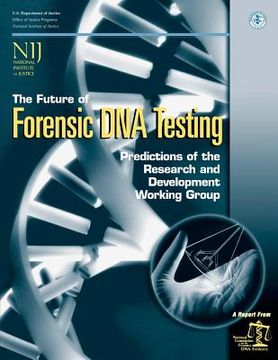The Future of Forensic DNA Testing: Predictions of the Research and Development Working Group (en Inglés)
Reseña del libro "The Future of Forensic DNA Testing: Predictions of the Research and Development Working Group (en Inglés)"
The principal assignment given to the Research and Development Working Group was to identify the technical advances in the forthcoming decade and to assess the expected impact of these on forensic DNA (deoxyribonucleic acid) analysis. Progress in forensic analysis was slow until recently, but since 1985 more powerful techniques have increased explosively. The first useful marker system, the ABO blood groups, was discovered in 1900. The second, the MN groups, came a quarter century later. By the 1960s, there were 17 blood group systems known, but not all were useful for forensics, and in the 1970s a few serum proteins and enzymes were added. By the 1980s, some 100 protein polymorphisms were known but most were not generally useful for forensics. The year 1985 brought a major breakthrough. VNTRs (variable number of tandem repeats) showed much greater variability among people than previous systems and immediately began to be used for forensic studies. They are still used, but are rapidly being replaced by STRs (short tandem repeats). We can also expect improvements in collection and purification techniques. Automation will make the process more efficient and rapid, and we expect interpretative software for analysis of complex problems, such as mixtures. There also is progress toward miniaturization, using a combination of chip technology and molecular genetics. Portable, handheld systems are now working in laboratory experiments; how soon these will be available for routine use is not clear. We also expect an increasing amount of re-examination of cases in which the conviction was based on evidence other than DNA. Greater automation and higher throughput approaches will help reduce the backlog. Formats that can analyze multiple STR loci in miniaturized, mobile instruments are promised and should be available by this time. We also expect improved sampling and storage techniques. Research in the human genome and clinical research will produce many more markers, some of which will be used to supplement the existing procedures. We also expect integration of computers and internet with analytical techniques to permit direct transmission of test data between laboratories. There may be some transition to new technologies, mainly to supplement the standard STRs. SNPs will be widely used in medical and agricultural research, so there will be many opportunities to carry these over for forensic purposes. Within 10 years we expect portable, miniaturized instrumentation that will provide analysis at the crime scene with computer-linked remote analysis. Although this report looks to the future, we emphasize that current state-of-the-art DNA typing is such that the technology and statistical methods are accurate and reproducible. STRs have proved to be very satisfactory for forensic use and are being rapidly adopted by forensic laboratories. The difficulty and expense of changing well-established and reliable procedures will inhibit changes to other systems. For this reason, we believe that STRs will be the predominant procedure during the next decade. Methods of automation, increasing the speed and output and reliability of STR methods, will continue. In particular we expect that portable, miniature chips will make possible the analysis of DNA directly at the crime scene. Techniques for handling minute amounts of DNA or DNA that is badly degraded will become much better. In particular, mitochondrial DNA will probably play an increasing role in such difficult cases. Databases of DNA profiles of convicted felons will be extensive and coordinated throughout the States. International comparisons will be feasible and increasingly common. In the future, it is likely that an increasing number of suspects will be identified by database searches. The statistical interpretation is difficult, particularly if future databases include representatives of the population at large rather than convicted felons.

